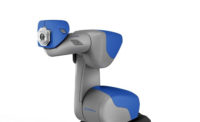Manufacturers always give their customers what they want. When it comes to dishwashers, consumers worldwide want durability.
In Dillinger, Germany, for example, Bosch Siemens Hausgeräte GmbH (BSH) makes durability a priority while operating Europe’s largest and most modern dishwasher plant. There, workers produce nearly 10,000 machines per day in two shifts on seven assembly lines.
When the facility opened in 1960, Robert Bosch GmbH produced fuel pumps. Several years later, Bosch made food processors there. Today, BSH uses a wide range of advanced machines to produce high-quality dishwashers.
One of those advanced machines is the mobile flexFellow unit equipped with an LBR iiwa lightweight collaborative robot. Made by KUKA Systems GmbH, the unit has been in use for production at BSH since 2016 after a successful pilot program lasting several months. It is industrial-grade and works safely with humans in open or confined spaces. The company also likes that the unit can be easily brought to the site of an assembly operation.
For BSH, the LBR iiwa robot fastens a pump well into each dishwasher housing. Screws are automatically separated and fed to the robot, which tightens four of the fasteners in 16 seconds. Torque sensors in each joint enable the robot to find the screw locations and press down on the pump well to ensure proper seating before fastening. Custom end-of-arm tooling was made by Weber Schraubautomaten GmbH.
According to Henning Borkeloh, head of advanced technology solutions at KUKA, BSH mainly selected the flexFellow because it can be safely used in the limited-space pump-wells workstation. Workers approach or stay near the robot during operation to observe and monitor the process—without the need for a physical fence.
In addition, the robot is quickly programmed, and immediately notifies the worker that the fastening operation is successful or not. Position and compliance control enable the LBR to handle delicate components without crushing them or creating shearing hazards.
Borkeloh says that the LBR robot is ideal for collaboration due to its light weight (less than 30 grams), seven axes of movement, moderate payload (7 or 14 kilograms) and sensitive capabilities. Torque sensors in all joints allow the robot to detect obstacles in the work area and immediately reduce its speed and force level.
The robot has a maximum reach of 800 or 820 millimeters, depending on the model. Position repeatability is ±0.15 millimeter, and torque accuracy is ±2 percent of the maximum torque. The robot is programmed via simulation: An operator indicates the desired position, and the robot remembers the path coordinates. Simple touch commands control all movement and stopping.
The flexFellow’s features include height adjustability, multiple service and operator interfaces, an additional mounting plate on the inside, easy access for servicing and maintenance, and a scratch-resistant function plate made of brushed stainless steel. Options include an emergency stop on the function plate, a pneumatic-components application package, and an interface to lock an additional carriage and peripherals.
Other flexFellow series products are a platform and carts with shelves to store and provide material. For more information on mobile robot units and collaborative robots, call 866-873-5852 or visit www.kuka-systems.com.





